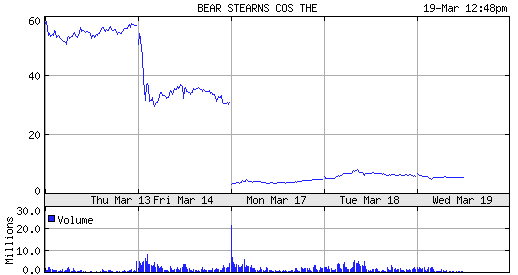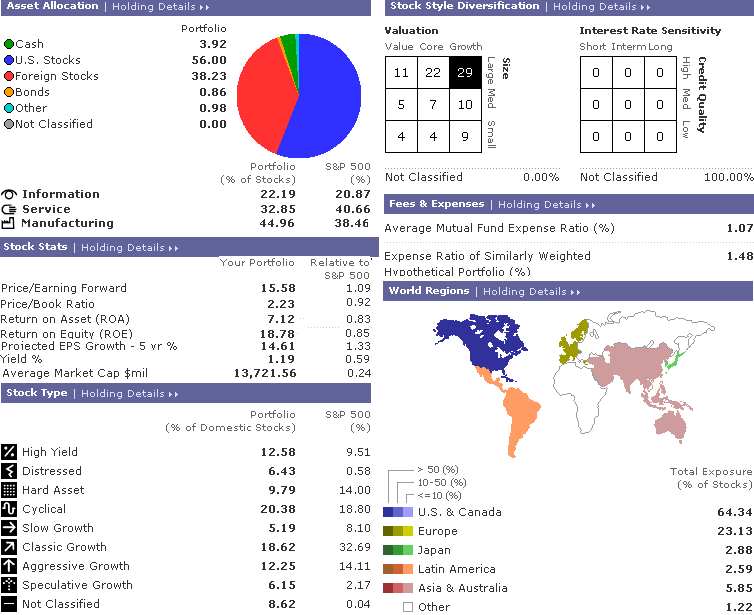



April
2008
"Apparently
we overestimated the intellectual capacity of the general viewing
audience when it comes to subjects financial.
We cannot compete with the likes of Cramer, YouTube
videos and characters from The
Simpsons.”
~ Another .com bites the dust.
| The Professional Opinion S&P 500 Index: 1322.70 Bob's model remains strongly in positive territory and he rates the market as a buy on any weakness that in the low 1300's. In March there were twin closing lows which were a bit below the January 22 closing level. Testing of that January closing low continued on into mid-March. Selling pressure was seen as drying up and is a key indicator for testing market lows. Economic Outlook First quarter real GDP is expected to be flat or a bit weaker. Retail sales and industrial production declined @ .5% The Fed's economic stimulus package is estimated to provide about 1% to the real GDP bottom line. 1-2% is the likely range for GDP in the second half of the year. 2009 Real GDP growth is expected to ramp up to 2-3%. Not much better, but better. One positive aspect of this is the strong demand for US exports in part fueled by the weak dollar. Investor Sentiment The Put-Call ratio was at historic highs in mid March with a reading of 1.266 (and that is high). The contrary indicator dropped slightly at the end of March with a reading of 1.09. Bob's sentiment index is solidly bullish territory. He views the market as attractive for purchase. The Fed The Fed got it right by bailing out Bear Stearns. The failure of a major Wall Street company could have had disastrous results. There is also encouragement in that there is improved real growth evident in M-2 money supply figures, which has been responding to the Fed's easy money policy. The 60 day put/call ration is still very high with a reading of 1.07. This contrary indicator measures investor sentiment. This and other gages suggest any further weakening of the economy will be brief and mild. There is a possibility of another rate cut at the Fed's next meeting but it is not a sure thing. The general rule of thumb is that it takes about six months to see the results rate cuts on the economy. Inflation is expected to remain in check because of weak economic growth, weak jobs market and high energy prices. "The key year over year personal consumption expenditure price index has risen 3.4%, but the core index has risen only 2%. The 19% gain in energy prices over the past year has not found its way into core prices in any meaningful way........" Portfolios No changes to portfolios. Summary "A gradual economic recovery beginning in the second half should extend into 2009 and provide the basis for significant earnings growth which is the basis for our positive market view." |
 |
| Up
in
the Yukon, what could be worse than 30 days of night? Let me
see...........Vampires
for one, would not be a good thing. |
Personal
Portfolio
What a weird month. The Bear Stearns fire sale was surreal. Monday morning I was looking at a $2.00 stock which used to be a $170.00 stock. I watched BSC climb to $4.00 after a sale was agreed to with JP Morgan to buy the stock at $2.00.  Took me a few minutes to figure out what that was all about. It dawned on me that such a sale would require shareholder approval and if I was an existing shareholder, I would be downright insulted. I thought the slowly climbing share price was probably because a few other people thought so too. The gambler in me flat could not pass this one up. I didn't have enough free cash so I sold some more RNIN on Monday and used the proceeds to play 'Wheel of Fortune'. The Wheel stopped on Tuesday for a 58% gain which more than offset the current loss on ABK. Probably going to get one of those 'settled funds' reprimands from the broker but it was worth it. Well how about that, they are playing nicer: What this means for your account. Please be assured that there are no restrictions on your account as a result of this trade, and you can continue to trade without settled funds or securities required on the trade date. However, we'd like to suggest that you exercise caution, as additional settlement issues may result in trading limitations. Thank you for your understanding in this matter. We recognize that trading regulations can be confusing. Once again, please contact us if you have questions. We appreciate your business and look forward to continuing to serve your trading and investment needs. You know, what would be helpful would be a simple explanation of the 'Settled Funds Rule', one that anyone could understand and I just happen to have one: 1. Sell Stock A, which you have owned for at least three trading days and use the proceeds to buy Stock B. (The funds used to buy Stock B need to 'Settle', which simply means accounting needs to catch up with the trade.) 2. Wait at least three trading days before selling Stock B. I don't know the exact number but if you violate this trading rule too many times, your trading privileges get suspended for up to three months. Would this prevent me from locking in a nice one day gain as in BSC? Heck no. Just don't violate the rule too many times. Now what to do with the proceeds - Sit on it and wait for another bargain basement opportunity Or: Or makes more sense. Buy back the RNIN shares I sold and keep the rest for another panicked wave of selling. Anyway, I was reading that Bear Stearns leveraging was at one point 30 to 1 which means for every dollar they had, they borrowed thirty. 30-1 odds on a horse race I can understand, but a company like that using that kind of leverage? Doesn't really inspire a lot of confidence in the banking industry, does it. This is yet another example of why one should follow the 4-5% diversification rule when it comes to stock ownership. Losing 98% of 4% would sting a little but it would not force changes to along anticipated retirement date. Cramer sure came out with egg on his face: Oops - CNBC's Cramer Said 'Don't Move' From Bear a Week Before Collapse 'Mad Money' host drastically underestimated the investment bank's trouble surrounding the mortgage crisis. By Jeff Poor Business & Media Institute 3/17/2008 3:19:20 PM Hopefully your financial portfolio didn’t include stock in Bear Stearns, but it might have if you had listened to CNBC’s Jim Cramer. After it was announced March 16 that J.P. Morgan Chase & Co. (NYSE:JPM) was purchasing Bear Stearns Cos. (NYSE:BSC) for $2 a share, the stock plummeted over 80 percent at the open of trading on March 17. But, on March 11, Cramer told an e-mailer not to sell the beleaguered investment bank’s stock on his show’s Web site: “Dear Jim: Should I be worried about Bear Stearns in terms of liquidity and get my money out of there? --Peter Cramer says: “No! No! No! Bear Stearns is not in trouble. <Audio Here> If anything, they’re more likely to be taken over. Don’t move your money from Bear.” On Jan. 17, 2007, Bear was trading at its high of $171.51 a share. Since then, it has been racked by the mortgage turmoil. On March 11, when Cramer posted the e-mail and his response, the stock closed at $62.97. As of 10:00 a.m. on March 17, the stock was trading at $3.72 a share. Cramer frequently appears on “NBC Nightly News” and “Today.” On the January 22 “Nightly News,” Cramer was referred to by his colleague Carl Quintanilla as “one of the most influential voices on Wall Street.” On the “Today” show March 17, Cramer maintained that “if you’re a diversified investor, you’re not going to get hurt” by the Bear Stearns collapse. “Those who only had their money in Bear obviously will get wiped out today. But you most importantly don’t have to take your money out of a bank,” he said. Cramer clarified his remarks on CNBC’s March 17 “Street Signs”: “Look, let’s understand two things,” Cramer said. “I said the common stock was worthless on Friday, as soon as this thing was at 36 because we saw a look at the bonds. If you kept your money in Bear you made out. You got the liquidity. Keeping money at Bear – I guess I could have caused a run on the bank and said take your money out of Bear. I guess people could say hold it, he’s saying buy the common stock. I mean, what the heck. I cannot cause a run. It turned out the Federal Reserve guaranteed the money. I’m not going to tell people to pull money out of these places. The Federal Reserve is guaranteeing the money. They are not guaranteeing the equity. I got a lot of things wrong in my life, but I don’t regret the fact when I said don't take your money out of Bear. If you have your money in Bear you still got it today. Remember, there’s Bear Stearns the common and that person was going to pull the money out of Bear. We got a guarantee. J.P. Morgan is now Bear.” Did Cramer's 'clarification' mean as much to you as it did to me? A Reader sent an email the other day and asked if I wouldn't mind sharing the stupidest thing I ever did - financially. Boy, this is an easy one: Anyone who has been around a while ever heard of Independent Energy Holdings (INDYY)? Notice the use of the past tense. At the end of the Dot.Com bust you could throw money at any rumor and odds are you would walk away with more than you invested at the end of the day. I didn't exactly day trade but I was at least week trading. I wasn't a total idiot though. I kept about 10% cash for trading and the rest went to mutual funds. When the cash pile got greater than 10% (and it did in amazingly short order), I would distribute the difference among the mutual funds I owned which were doing extremely well too. I remember Strong Growth posted a 100% return one year. I never invested more than 25% of the 10% pile in any one stock. Usually the amounts were less than that. INDYY was a company in the UK who had power plants and also brokered energy contracts. One day I was talking power plants with someone 'in the know' and he told me to keep this under my hat, but he had it on very good authority that a major US power producer was sitting on a pile of cash and was going to buy Independent Energy Holdings. The announcement would in all likelihood send the stock soaring and the deal was imminent. Not being totally stupid, I did some minimal research on the company and decided to go a whole 5% in 2.5% chunks. I forget the price but I think it was somewhere around $12.00 a share. And not being totally stupid, I put in a couple trailing stops. Over the course of a week or two the stock drifted up a bit and down a bit. One morning I logged in and found that trading had halted for some reason and the stock was sitting at @ $5.00 a share. I wasn't too concerned though because I had those trailing stops. Well, those trailing stops never happened because the stock price opened below my trailing stops and then trading suspended. There was nothing I could do. I lost the whole 5%. Granted in the big scheme of things, a 5% loss is not the worst thing that could happen but I don't like to lose........much. The loss was quite sobering. I remember those final days of the bubble quite well. Somewhere around January of 2000 I was getting very skittish about the market. There were people predicting Dow 36000, there were dot.coms going public which didn't have a business model at all. Investors small and large could not help but make lots of money unless they were total idiots. Heck, total idiots were making money too. I was set to pull the plug. About two weeks later, Bob Brinker came out with a 'evacuate the market' sell order and suggested going at least 60% cash. It was almost a relief. I spent the better part of the morning selling everything and going to cash. I think I went about 80% cash when all was said and done. I made copies of the sell order from Bob and gave them out to everyone I knew. Only two people heeded the advice and I think both of them went 100% cash because they were more scared than I was. The next six months were disastrous. Two guys I knew who worked as partners who got a $160,000 margin call hit them and they were promptly wiped out. One guy got a $230,000 margin call. He was in his late 50's and lost almost everything. I knew people who turned into LVLT millionaires during those last days. They never sold at the top and kept buying as the stock drifted from $80.00 plus a share (after a couple splits too) down to the $2.00 range. Some of these people lost their entire retirement nest egg - and they were in retirement. I also knew people who went to work for Calpine and transferred their company 401K's into Calpine stock, only to see the stock price plummet and the stock itself drift down off the big boards and onto the Pink Sheets. Greed is good when you can see it for what it is, capitalize on it and have the common sense to get out of the way when the tide turns. Unfortunately, most of us aren't quite wired that way and there are always people out there more than happy to take advantage this particular human frailty. So what did I learn from all of this? My 10% play money is reduced to 5%, and usually less than that. I now only think in percentages: Move a percentage of this, buy a percentage of that, sell a percentage of the other. This is where Excel Pie Charts come in handy. They give you a good graphical representation of your total portfolio.  Morningstar's Instant X-Ray is another good way to shed some reality on what you actually own. I treat all my accounts as one account. I used not to do this and it resulted in weightings getting skewed into sectors I may not have been comfortable with. Don't rely on one single source of information and don't act on tips from a friend without a wholllllllle lot of DD. I have more patience. I won't trade if I believe I can make a little. I will trade if I think there is the possibility of making a lot and I don't mind waiting. This is kind of where I see RNIN and SIMG. I think over the longer run, these could give me some very nice returns. I thought OC would be a long term hold too and I didn't think the housing crunch would hit this one as hard as it did. Did ok on that one though since I bought and sold several times and finally got stopped out the last go round. Trailing Stops don't always work. If I think there is a reasonable possibility that a stock could blow through my stops, I don't invest in the stock. Period. I Won't invest in it if I don't understand it. Boy, this for me is probably the hardest one to comply with. I think I will borrow a page from the Lib's handbook and change the rule to something I am comfortable more with: If I don't understand it but think I can make a pile of cash in the short run, invest about half of what I normally would and use trailing stops. Last but not Least: Diversify, Diversify, Diversify. |
